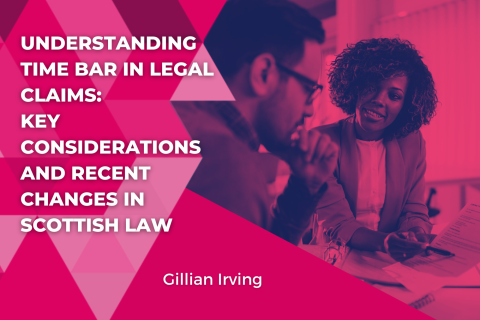Most legal systems around the world have a limit whereby the Pursuer must raise a claim; this is widely known as time bar. Alternatively, in Scotland, it can be known as prescription, and in England, it is known as limitation. This is a key factor to be aware of when someone is considering raising a court action. The important principal is that a claim must either be settled extra-judicially or court proceedings must have been raised and served against the responsible party within the time limit provided, otherwise their right to claim will fall. The purpose of time bar is to make sure that claims are dealt with in a timely manner and to prevent businesses and individuals having the threat of litigation hanging over them for an indefinite period of time.
The table below shows the different time limits which apply for different cases in Scotland. The general five-year rule is governed by the Prescription and Limitation (Scotland) Act 1973, Section 6 and Section 17 sets out the position in regard to personal injury cases.
| Type of Case |
Time Bar |
| Claim for damages involving a personal injury |
Three years |
| Claim for damages with no personal injury (e.g. damage to your car) | Five years |
| Payment of a debt | Five years |
|
Claim for
personal injury sustained at sea or in a plane | Two years |
It is vital that claimants are aware of when the clock begins to tick so that they do not miss the deadline for raising a claim. There have been some issues with the five-year clock and when it is deemed to have commenced under the 1973 Act. As per Section 11 of the 1973 Act, the clock is deemed to have commended at the point in which the act which causes loss, injury or damage occurs. This was problematic in instances where the claimant was not aware or could not have been reasonably aware that loss or damage had occurred until sometime after the event.
As a result, Section 5 of the Prescription and Limitation (Scotland) Act 2018 was introduced. This came into force in June 2022 and it replaced the existing test for starting the five-year clock. Now, the clock will not commence until the claimant is aware of the following:
- that loss, injury or damage has occurred;
- that the loss, injury or damage was caused by a person's act or omission; and
- the identity of that person.
It is clear that time bar is something which must be at the forefront of your mind if you are considering raising a court action and the aim of Section 5 of the 2018 Act is to prevent the five-year clock commencing before the claimant becomes aware of any issues.
If you believe that you may have a claim, it's crucial to take action promptly. Make sure you understand the time limits that apply to your case, as missing the opportunity to raise a claim could mean losing your right to it. Don't wait until the clock runs out—consult with our experienced team of litigation specialists who can guide you through the process and help you secure your rights. We invite you to call 0141 221 1919 to ensure you are well-informed and prepared to move forward with your claim.















